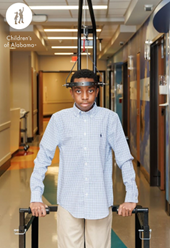Photo Courtesy of Childrens of Alabama
Collaboration between the University of Alabama at Birmingham School of Engineering and Children’s of Alabama is providing several young patients with the opportunity for a healthier future faster.
In 2020, a team of senior design students in the class of Alan Eberhardt, Ph.D., developed a halo traction walker as a part of the Biomedical Engineering Capstone Senior Design course.
The traction walker was designed to maintain traction of the spine, which is a corrective decompression process to help it stretch and straighten. Required before fusion surgery, the process of traction prevents mobility for patients and the use of a halo traction walker allows for patients to retain some mobility without disrupting the rehabilitative process.
The students were able to create a working prototype; however, due to the COVID shutdown, the project was temporarily abandoned. In recent years, Steve Thompson, manager of the Design and Fabrication Laboratory in the UAB Materials Processing and Applications Development Center, continued to work on and perfect the device. The Design and Fabrication lab partners with many different areas of the university to provide unique deliverables and skills, such as welding and prototype design.
The capstone course gives BME students the chance to put their engineering skills to the test with design and construction of a device that will help a real client who has presented a real biomedical engineering problem,” Eberhardt said.
Now in 2023, physicians at COA have been able to successfully supply multiple patients with mobility during the needed traction for spinal fusion surgery via the walkers prepared directly on the UAB campus.
“This was one of those projects where students were able to create a device that was needed but didn’t exist in the marketplace,” Thompson said. “There isn’t a big enough demand to make it profitable for a medical device company to manufacture these. Even if they did, each one would have to be customized for each patient. So, doctors and physical therapists end up improvising and cobbling something together for each patient.”
Eberhardt says Rhett Wheeler, DPT, at COA is a frequent partner in the UAB senior design classes.
“Dr. Eberhardt has been our champion for years now. He connected us with Dr. Sicking, who helped fund our research and fill in the gap to get the needed parts for the walker,” Thompson said.
“He has brought us several good projects in the past where he had a need that was not being met or a challenge that was not being addressed by existing products in the marketplace,” he said.
In May of 2023, Wheeler, director of Physical Therapy and Occupational Therapy at Children’s of Alabama, reached out in need of a traction walker for a patient.
Thompson elaborated and said, “We had already been working on the third-generation prototype. Dr. Wheeler sent us the specifications he needed, and we were able to have it over to the hospital later that afternoon.”
Due to a successful experience, Wheeler later requested the device for use with three other incoming patients in the fall.
“This project was different. I was hesitant at first because we really had no funding for it,” Thompson said. “But seeing the effort Children’s was going to, I knew they really needed this to progress further.”
Thompson and the DFL team used their own resources and budget to produce what was needed for the patients.
“It’s been very rewarding to witness our efforts go directly toward helping people, especially young people,” Thompson said. “Most of our work is research-based, and while we do see good things happen, it’s typically a much longer process. With this project, we were able to witness the fruition much faster, and it’s a great feeling knowing the work of our team has had such a positive impact.”
Thompson plans to develop a next-generation prototype in the fu





